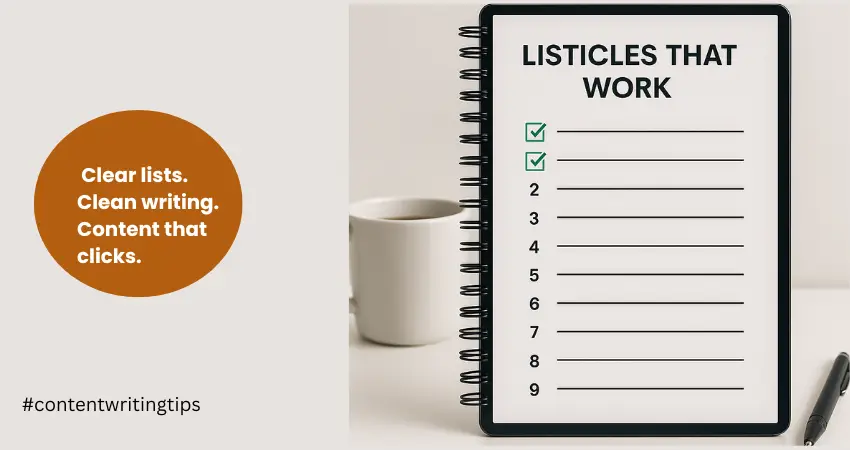Listicles are popular for a reason. They help readers get the point quickly. Whether it’s “5 Ways to Grow on LinkedIn” or “10 Freelance Writing Tips That Actually Work,” listicles break complex ideas into clear, digestible steps. But writing a good listicle isn’t just about listing things. It’s about structuring your content to add real value — not just take up space on the internet.
I’ve written all kinds of blog posts — tutorials, explainers, case studies. But listicles? They’re one of the easiest formats to write well and one of the easiest to mess up. A listicle is more than just a bunch of bullet points. When done right, it gives your reader a clear path, real takeaways, and a reason to keep scrolling.
Here’s how to write one that works.

Table of Contents
ToggleKey Takeaways
- A listicle is a blog post or article structured as a list.
- Each item should offer practical value — no filler.
- Use examples, order points logically, and format consistently.
- A strong title and internal linking improve reach and credibility.
- Best for readers who prefer skimmable, high-utility content.
1. Make Sure Your Content Makes Sense in a List Format
Start with the topic. Ask: Can this be broken into clear, stand-alone points? If yes, it’s a good fit for a listicle.
For example, “Tips to Improve Blog Headlines” makes sense as a list — each tip can stand alone but still build toward the goal. But “My Journey as a Writer” doesn’t benefit from being in numbered format. That’s a personal story, not a list.
Tip: If you feel the need to keep adding context between list items, it may not be a listicle-worthy topic
2. Include Valuable Takeaways — No Fluff!
Every point should offer something useful. Don’t just repeat what everyone else is saying. Ask:
- What does the reader get out of this?
- Can they apply it right away?
Avoid filler like “Be consistent.” Instead, say how to stay consistent — use a content calendar, write at the same time daily, or batch your posts weekly.
If it doesn’t teach, guide, or help, cut it.
3. Link to More In-Depth Information When Necessary
Listicles aren’t meant to explain everything in detail. But they should point readers to where they can learn more. Add internal links to your own blogs or trustworthy external sources.
Example:
If one point in your list says “Use a strong CTA,” link to a full blog that breaks down CTA writing techniques with examples.
This not only adds SEO value but keeps your content useful even for advanced readers.
4. Explain List Items Using Relatable Examples
People remember examples more than abstract advice.
Instead of saying, “Write short sentences,” show a before-and-after version:
Before: Despite the fact that it was raining, she still went out.
After: It was raining. She still went out.
Examples make your advice feel real. They also show that you’ve used the tip yourself or thought it through, which builds credibility.
5. Number Your Items
Readers love numbers. They signal structure. And in a sea of content, they help people decide whether they have time to read your post.
Odd numbers often perform better (e.g., 7 or 11 instead of 10 or 20), but that’s not a rule. What matters more is that the number matches the value you’re offering. Don’t add fluff just to hit a number.
Bonus Tip: Mention the number in the title. Example: “7 Ways to Make Your Writing Stronger”
6. Include an Appropriate Number of List Items
Too few, and your post feels incomplete. Too many, and your reader may bounce.
For most educational blogs, 6–12 items work best. If you go beyond 15, make sure each item still delivers something new. Repetition weakens trust.
Quality always beats quantity. Readers will thank you for cutting what isn’t essential.
7. Use Category Buckets for Longer Lists
If your list goes beyond 12–15 items, break them into sections with mini-headings. It gives visual breaks and improves readability.
Example:
In “21 Tools Every Writer Needs,” you might divide them like this:
- Writing & Editing
- Visual & Design
- SEO & Analytics
Category buckets also help you avoid repeating similar tools or tips.
8. Logically Order Each Step
There are three ways to order list items:
- Chronologically (for how-to guides or tutorials)
- By priority (start with the most impactful)
- By category (if you’re grouping items)
Avoid random order unless it truly doesn’t matter. Structure helps people follow your logic and feel guided — even when skimming.
9. Make Sure Your Listicle Is Consistent
Consistency in tone, format, and length improves trust and makes the post easier to read.
If one point is a sentence and the next is four paragraphs, it feels jarring. Likewise, switching tone from formal to casual can confuse the reader.
Keep sentence structures similar. Start each item with an action verb if you’re giving tips. For example:
- Avoid jargon
- Write shorter intros
- Show, don’t tell
10. Have a Clear and Catchy Title
Your title should grab attention without misleading the reader.
Start with a number, include your main topic, and hint at the value inside.
Examples:
- “10 Ways to Hook Readers With Your Opening Line”
- “7 Signs Your Freelance Pitch Needs Work”
Avoid vague titles like “Writing Tips You Should Know.” They don’t stand out — and they don’t tell readers what they’ll learn.
Final Thought
Listicles aren’t lazy writing. When structured right, they deliver focused value, reduce reader fatigue, and boost engagement. They’re a smart format for writers who want to share practical advice without overwhelming their audience.
Whether you’re creating content for brands or building your own writing blog, learning to write a clean, useful listicle is a skill worth having.
Need help turning your ideas into high-performing content?
I write SEO-friendly blog posts, listicles, and web content that connect with real readers — and drive results.
Work with me or drop a message to see how I can support your brand’s content goals.
